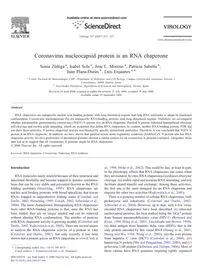
2007 Coronavirus nucleocapsid protein is an RNA chaperone PDF
Preview 2007 Coronavirus nucleocapsid protein is an RNA chaperone
Coronavirus nucleocapsid protein is an RNA chaperone Sonia Zúñiga a, Isabel Sola a, Jose L. Moreno a, Patricia Sabella b, Juan Plana-Durán b, Luis Enjuanes a,⁎ a Centro Nacional de Biotecnología, CSIC, Department of Molecular and Cell Biology, Campus Universidad Autónoma, Darwin 3, Cantoblanco, 28049 Madrid, Spain b Fort-Dodge Veterinaria, Department of Research and Development, Girona, Spain Received 29 June 2006; returned to author for revision 11 July 2006; accepted 29 July 2006 Available online 18 September 2006 Abstract RNA chaperones are nonspecific nucleic acid binding proteins with long disordered regions that help RNA molecules to adopt its functional conformation. Coronavirus nucleoproteins (N) are nonspecific RNA-binding proteins with long disordered regions. Therefore, we investigated whether transmissible gastroenteritis coronavirus (TGEV) N protein was an RNA chaperone. Purified N protein enhanced hammerhead ribozyme self-cleavage and nucleic acids annealing, which are properties that define RNA chaperones. In contrast, another RNA-binding protein, PTB, did not show these activities. N protein chaperone activity was blocked by specific monoclonal antibodies. Therefore, it was concluded that TGEV N protein is an RNA chaperone. In addition, we have shown that purified severe acute respiratory syndrome (SARS)-CoV N protein also has RNA chaperone activity. In silico predictions of disordered domains showed a similar pattern for all coronavirus N proteins evaluated. Altogether, these data led us to suggest that all coronavirus N proteins might be RNA chaperones. © 2006 Elsevier Inc. All rights reserved. Keywords: RNA chaperone; Coronavirus; Nidovirus; RNA synthesis Introduction RNA molecules easily misfold because of their structural and functional flexibility and become trapped in inactive conforma- tions that can be very stable and persistent (known as the RNA folding problem) (Herschlag, 1995). RNA chaperones are nucleic acid binding proteins, with broad specificity, that rescue RNAs trapped in unproductive folding states (Cristofari and Darlix, 2002; Herschlag, 1995; Lorsch, 2002; Schroeder et al., 2004). The main characteristic distinguishing RNA chaperones from other RNA-binding proteins is that, once the RNA has been folded, they are no longer needed and can be removed without altering RNA conformation. The number of proteins with RNA chaperone activity is growing steadily (Cristofari and Darlix, 2002; Rajkowitsch et al., 2005). There are several assays to analyze the RNA chaperone activity of a protein in vitro (Cristofari and Darlix, 2002), but only recently it has been shown that a protein acts as an RNA chaperone in vivo (Clodi et al., 1999; Mohr et al., 2002). This could be due, at least in part, to the pleiotropic effects that RNA chaperones can cause when they are mutated. In vitro, RNA chaperones (i) enhance ribozyme cleavage, (ii) enable rapid and accurate RNA annealing, and (iii) facilitate strand transfer and exchange. Among these activities, the first one is the most stringent for an RNA chaperone and requires the other two activities (Rajkowitsch et al., 2005). There is a growing number of cellular RNA chaperones, both prokaryotic and eukaryotic (Cristofari and Darlix, 2002; Schroeder et al., 2004). However, up to date, only a few virus- encoded RNA chaperones have been described: (i) retroviral nucleocapsid proteins, the best studied being the NCp7 protein from human immunodeficiency virus (HIV-1) (Bertrand and Rossi, 1994; Hong et al., 2003; Tsuchihashi and Brown, 1994), (ii) delta antigen from hepatitis delta virus (HDV), that is the only protein encoded by this viroid RNA (Huang et al., 2003; Huang and Wu, 1998; Wang et al., 2003), (iii) the core protein from hepatitis C virus (HCV) (Cristofari et al., 2004), (iv) hantavirus N protein (Mir and Panganiban, 2005, 2006), and (v) poliovirus 3AB protein (DeStefano and Titilope, 2006). Most of these viruses have RNA genomes requiring tightly regulated Virology 357 (2007) 215–227 www.elsevier.com/locate/yviro ⁎ Corresponding author. Fax: +34 91 585 4915. E-mail address:
